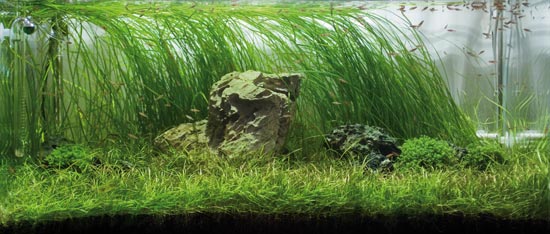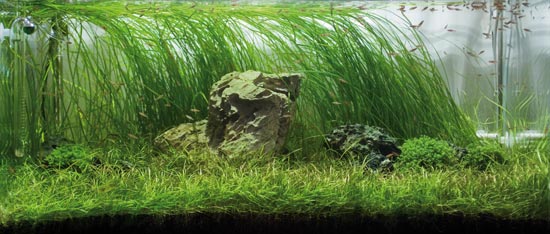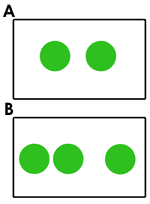
The term Iwagumi is commonplace in the aquascaping world. It is used to refer to an aquascape that traditionally uses stone as the only hardscape material. Iwagumi’s are captivating and beautiful: they seem to have a mystical sense to them and an ability to captivate even the most fidgety of people – it is hard to forget your first Iwagumi, but what exactly is an Iwagumi? Read on to find out…

The term Iwagumi was originally used to refer to a Japanese gardening style in which stones were used as the ‘bones’ of the garden, to provide its structure: if the stones are well placed in the garden then the rest of the garden lays itself out. Japanese gardens used stones, shrubs and sand to represent landscapes in miniature, so they could show a mountain scape by using carefully placed stones or represent the ocean or a lake with a pool of raked or unraked sand. As the popularity of gardening led to the emergence of underwater gardening, which we now know as aquascaping, the tradition of Iwagumi naturally inspired and influenced aquascapers. Iwagumi is one of the most striking and simple formations, representing a mountain scape or Buddhist triad so it is well suited to aquascaping.
The number of stones
Not all Iwagumi’s have just three stones – any number of stones can be used in an Iwagumi. Those with more stones have an added element of complexity and intricacy whilst those with fewer stones like Sanzon Iwagumis, which have just three stones, possess a striking, symbolic elegance.
Whilst there is no rule about the maximum number of stones it is best to use an odd number – so 3, 5, 7 or 9 stones. This is because humans have a tendency to arrange things in a stylised or symmetrical way, which is very unnatural and quite unbeautiful. It is ironic that we are naturally drawn to patterns of randomness and even chaos but that when we attempt to create something beautiful we instinctively revert to stylised patterns that we find unattractive. Using an odd number of stones prevents this and makes the Iwagumi more attractive and natural. It also prevents the scape appearing to be ‘split’ – with an even number of stones on either side.

A: An even number of rocks tend to split evenly.
B: An odd number of rocks prevents an even split.
Sanzon Iwagumi
There are several different kinds of Iwagumi – in Sanzon Iwagumi three stones are used: one larger stone and two smaller flanking stones that lean towards the larger one. This is called Sanzon Iwagumi because the three stones are likened to Buddhist triads. Sanzon Iwagumi has a very distinctive atmosphere: it is almost regal in its majestic elegance.
An Iwagumi Layout: The Names and Functions of the Rocks

As explained by ADA, each rock in an Iwagumi has its own name and function. When selecting your stones it is important to bear in mind their purpose within the aquascape. It is best to use the same type of stone throughout the Iwagumi aquascape.
Oyaishi
This is the primary stone in the layout. It should be the largest and most beautiful stone and have a striking character and form. The Oyashi or primary stone should be around 2/3 the height of the aquarium as this ratio appeals to the human eye as explained by the theory of The Golden Ratio, otherwise known as the Rule of Two Thirds which is used in all art forms from painting to aquascaping. Read more about The Golden Ratio in our article here.
The Oyashi should also be tilted. Whilst Oyashi in Japanese gardens tend to stand upright, in aquascaping the stone should be tilted to represent the flow of the water and create a more natural look – if the stone were in a river it would naturally be tilted because of the force of the water flow. By tilting the Oyashi we achieve the most natural and beautiful effect.
Fukuishi
This secondary stone should be the second largest and is placed on either the left or the right hand side of the Oyaishi or primary stone. The Fukuishi should be a similar texture and the same type of stone as the Oyaishi.
Soeishi
This tertiary stone is placed next to the Oyaishi, along with the Fukuishi. The Soeshi plays an important role in the flow of the Iwagumi by bolstering the strength of the Oyaishi or accentuating its presence.
Suteishi (a sacrificial stone)
The Suteishi is a small stone that does not stand out in its own right, and may even become hidden by plants over time. The Suteishi can be omitted from the aquascape if you are creating a Sanzon Iwagumi, which has a more striking presence. The Suteishi adds an element of subtlety, intricacy and complexity to the Iwagumi.
Laying out a traditional Iwagumi
1) For a traditional Iwagumi, lay an even layer of substrate across the floor of the aquarium. More substrate will be added after the stones have been placed.
Note: If you want a more complex and varied Iwagumi then the substrate can be layed more thickly at the back or back corners of the aquarium.
2) Next, place the Oyaishi. It is important to place the Oyaishi first. Place it in accordance with the Golden Ration or Rule of Two Thirds – so the stone should be about 2/3 the height of the aquarium and placed at a point that is about about 2/3 the width of the aquarium.
3) Then arrange the remaining rocks in descending order of size, placing the largest first and the smallest last: Fukuseki first, then Soeishi and finally Suteishi last. Pay attention to the balance of the angles of the rocks to help you place the stones.
4) When you have a layout that you are happy with (and this may take a couple of attempts!), it is best to leave the aquarium for a day or two so you can consider the layout for a while.
5) Finish the layout by using a cup or container to carefully pour more substrate over it to mound the substrate naturally. Let the substrate flow naturally between the stones. Finish with a layer of Aqua Soil Powder for a fine effect. Read more about Aqua Soil powder in our article here.
Planting an Iwagumi
Aquatic plants can soften the visual impact of the stones, so they can be used to create a harmonious balance within the aquascape. Low growing plants can be used to accentuate the details of a rock arrangement. Planting low growing plants in between the rocks or next to them is critical to enhance the natural effect, but make sure to use low growing plants that will not obscure the structure of your Iwagumi. Suggested plants include Hemianthus callitrichoides ‘Cuba‘, Eleocharis parvula (hair grass), Eleocharis acicularis – Exceptional Value Range and Glossostigma elatinoides to name but a few.
Higher growing plants such as Eleocharis vivipara can be used in the background of an Iwagumi to add depth and intricacy to the scape if desired.
Your Iwagumi
Browse our extensive range of hardscape here, and start planning your personal exploration into the world of Iwagumi now! All our stones and rocks are 100% natural, designed by Mother Nature, and perfect for your Nature Aquarium Iwagumi;
- ADA Seiryu Stone (featured in the above photographs).
- ADA Manten Stone (The most desirable ADA stone available!)
- TGM Blue Stone (An excellent budget choice- very cheap!)
- ADA Ryuoh Stone
- ADA Dragon Stone
- ADA Yamaya Stone
- Fossilised Wood
- Lava Rock (An inexpensive option)
Like this article? Other articles by The Green Machine that might interest you are;

What a nice informative article! Recently I have bought a 55 gallon aquarium and I can’t understand what is the best choice of my aquarium which seems so attractive and now to read your article I found the way and it is the iwagumi aquascapes. It is an uncommon idea for decorating an aquarium. I will definitely use this. Thank you so much for sharing such a well-written article.
Nice article, very informative. But this page contains many dead links. Please update them.
Hi Raghu, sorry about the dead links. We are working to fix them all but it may take us some time. Glad you like the article! 🙂